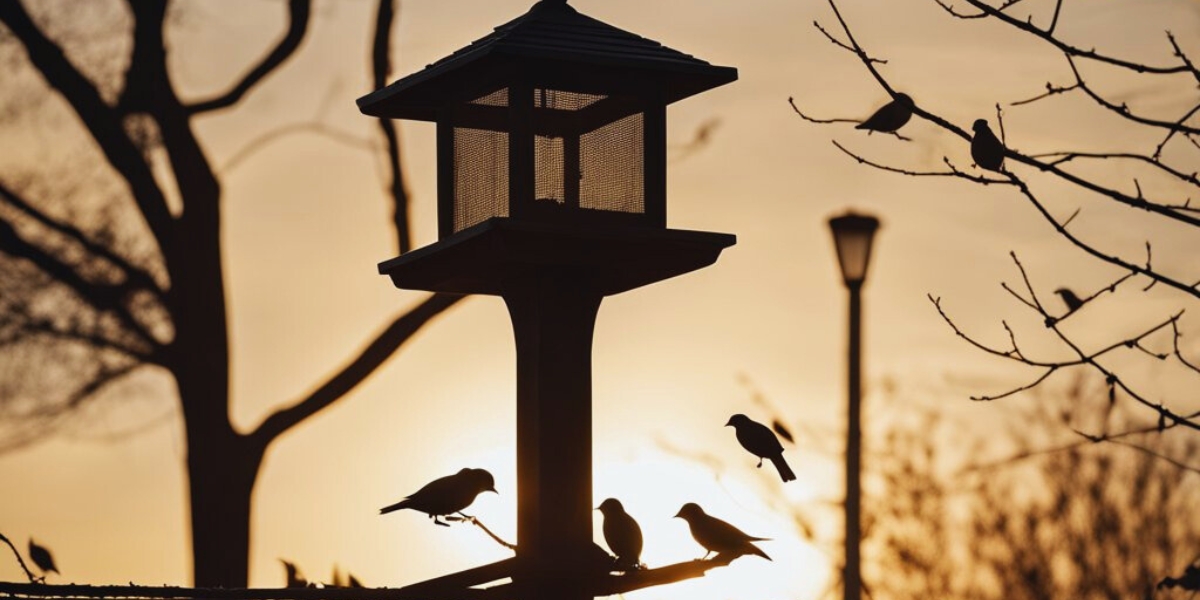Winter can be a harsh time for birds as natural food sources become scarce. Many birds rely on supplemental feeding from humans during the colder months to help them survive. But when is the right time to stop feeding birds as winter transitions to spring? Knowing the ideal timeline for ending your backyard bird buffet ensures you support their natural behaviors while avoiding potential harm.
Understanding the Importance of Winter Bird Feeding
Supplementing birds’ diets with feeders provides essential sustenance when insects, berries, and seeds are limited. Offering high-energy foods during cold snaps gives birds fuel to maintain body heat. Shorter days mean less time for foraging, so feeders help bridge the gap. Feeders also provide social gathering spots and protection from the elements. Providing winter bird food can mean the difference between survival and starvation for many species when natural food supplies are impacted by snow, ice, and freezing temperatures. Supporting their nutritional needs responsibly during winter is a rewarding way to boost bird health and diversity in your area.
Identifying the Best Bird Feeders for Winter
To make the most of your winter bird feeding, use feeders designed for cold conditions. Look for durable materials like metal, thick plastic, and weather-resistant wood. These withstand freezing rain, snow loads, and other harsh weather. Choose feeders with perches and openings sized for winter birds versus migratory species. Avoid metal perches, as birds’ feet can stick to cold metal. Dome-shaped or enclosed feeders offer shelter. For ground feeding, use a covered tray feeder to protect seed from snow. Place feeders in a protected area to minimize exposure to wind, rain, and snowdrifts. Having multiple feeder styles and locations attracts more species. Prioritize easy cleaning and filling for convenience through winter.
Choosing the Right Bird Food for Winter
Offering the appropriate foods for winter helps meet birds’ increased energy demands. Black oil sunflower seeds provide the highest calories for winter birds. Sunflower chips and hulled peanuts also pack energy and fat. Suet is a nutritious winter food high in fat and protein. Try no-melt suet designed for high temperatures. Nyjer seed offers tiny, oil-rich bites for finches. Safflower is enjoyed by cardinals, chickadees, and titmice. Cracked corn gives energy but avoid mixes with a high percentage of filler grains. Peanut butter can help birds refuel but look for all-natural kinds. Provide a variety of foods to attract the most species through winter. Also offer fresh water in a heated birdbath or de-icer to prevent dangerous dehydration.
The Best Time to Stop Feeding Birds in Winter
Generally, continue feeding birds through late winter and early spring. Stop too soon, and birds still relying on the feeders will be deprived of nutrition. End feedings too late, and birds miss cues to start natural foraging. Look for signs of spring like temperatures consistently above freezing, early migrant arrivals, growing vegetation, and emerging insects. As these signs appear, slowly reduce feeding over 1-2 months. This gives birds time to transition back to self-feeding. Exact timing depends on your location and weather patterns. For example, end feedings in late February for southern regions and late March or April further north. Allowing a gradual feeder fade-out versus abrupt cut-off helps prevent issues.
Adjusting Bird Feeding as Spring Approaches
In early spring, start decreasing feeder offerings to encourage natural foraging behaviors. Try these tips:
- Fill feeders less often, allowing periods to run empty
- Cut back the amount of seed provided each filling
- Limit feedings to peak need times like morning and night
- Move feeder setups farther from house foundations
- Remove one feeder every 2-3 weeks in rotating spots
- Offer more fruit options like berries and grapes as natural seeds sprout
Watch bird activity and cues in your yard. If feeder visits drop off as birds switch to insects and new plant growth, accelerate reducing efforts. Let nature guide the process based on conditions in your exact area.
Winter Bird Feeding Dos and Don’ts
Follow these dos and don’ts for responsible winter bird feeding:
DO:
- Clean feeders regularly to prevent disease
- Use quality seeds and blends to maximize nutrition
- Offer a heating source like a birdbath de-icer or heater
- Provide roosting pockets and covers for shelter
- Site feeders in optimal protected spots
DON’T:
- Allow seed to get wet and moldy in feeders
- Use mixes with fillers and artificial ingredients
- Feed breads or junk foods lacking proper nutrition
- Keep feeders up too late without slowly reducing
- Site feeders too close to windows or predators
Managing Bird Feeders During Winter
Cold weather brings considerations for managing winter feeding setups:
Prevent freezing: Choose feeders designed to stay ice-free. Maintain optimal seed moisture. Use popsicle sticks to prop open seed ports if needed.
Discourage rodents: Clean spilled seeds promptly. Use feeders with weight-sensitive perches. Install a squirrel baffle above feeders.
Avoid crowding: Spread feeders out over a larger area and use multiple styles to accommodate more birds comfortably.
Promote safety: Place feeders in sheltered spots away from predators. Install decals on windows to prevent collisions.
Reduce waste: Offer smaller amounts more frequently versus filling excessively. Remove old seeds and hulls to improve drainage.
With smart winter feeder management, you can maximize benefits for birds and minimize hassles.
Understanding the Benefits of Winter Bird Feeding
Offering supplemental food through winter helps birds in many ways:
- Provides vital energy and nutrients to survive seasonal scarcity
- Allows maintaining healthy weight and energy reserves
- Helps counteract frigid temperatures and maintain body heat
- Gives quick fuel sources amid shorter winter days
- Offers social interaction spots for flocking birds
- Creates shelter and cover from harsh weather and predators
- Provides water source when natural supplies freeze over
- Helps attract mating pairs to return to nest in your area
- Promotes winter bird diversity and numbers in your yard
The right winter feeding techniques can significantly boost backyard bird health, populations, and diversity based on their heightened seasonal needs.
Providing a Safe Winter Habitat for Birds
In addition to offering winter-specific foods in feeders, also focus on providing a safe habitat:
Wind barriers: Use native shrubs, fencing, or plant stands to block prevailing winds. This protects feeding and roosting areas.
Roost boxes: Install wood roost boxes to give birds a warm, secure overnight spot versusexposed branches.
Water sources: Use heated bird baths or de-icers for fresh drinking and bathing water. Provide some shallow water options.
Nesting sites: Ensure your yard offers protected nesting areas come spring like evergreens, dense brush piles, and cavity-filled trees.
Predator protection: Position feeders in optimal protected sites. Use deterrents to keep away predators attracted by feeders.
Weather shelters: Incorporate covered, cup-shaped feeders as well as brushes and roost boxesbirds can hunker down in during storms.
Evaluate needs beyond food to help birds safely survive through winter and transition to spring.
Adapting Bird Feeding Techniques to Winter Conditions
As winter weather shifts, adjust techniques to continue meeting birds’ needs:
During snow: Switch to elevated feeders. Use covered trays or hopper feeders. Opt for no-waste blends. Clear snow after storms.
In heavy rain: Move feeders under covered areas. Use dome feeders to keep seed dry. Limit soaked seeds which can mold.
During ice storms: Hang feeders from covered hooks or eaves. Use weather-resistant styles. Offer fruit, suet, and nut butter for easier access.
During cold snaps: Prioritize energy-rich, high-fat foods. Make sure water sources remain ice-free.
People Also Read:
Conclusion
Caring for birds through the winter by offering supplemental feedings and habitat support can have a huge positive impact on their health and survival. But it’s also crucial to know when to start slowly weaning birds off feeders as winter transitions to spring. Watch for signs in your yard and region that indicate natural food supplies are returning. Then gradually decrease feeding over 1-2 months to encourage natural foraging behaviors and migration cues. With some planning and a watchful eye on seasonal changes, you can seamlessly transition your yard’s feathered visitors back to self-feeding as spring arrives. Offering winter support, followed by a thoughtful feeding reduction, can help local birds thrive year-round.
Winter Bird Feeding FAQs
What are the first signs I should start reducing bird feedings in spring?
Some early signs it’s time to start cutting back on supplemental feeding include temperatures warming above freezing, sprouting plants and buds, the arrival of migrating species, insect hatches, and decreased activity at feeders as birds start natural foraging.
How long should the transition period be when ending winter bird feedings?
Plan on gradually reducing feedings over 1-2 months. This gives birds adequate time to adapt back to self-foraging without an abrupt loss of food supply.
What are the risks of stopping winter bird feedings too late?
Ending winter feeding too late can prevent natural migration and foraging behaviors. It can also attract predators to areas where nesting will occur.
Should I take down feeders completely or just reduce feeding amounts?
It’s best to incrementally remove some feeders while reducing filling amounts in others. This eases the transition by slowly lowering food availability versus eliminating it completely.
What foods should I shift to as the main winter feedings end?
As spring emerges, offer more fruit options like raisins, berries, and grapes while reducing high-fat seeds. This supports the change to natural food sources.

